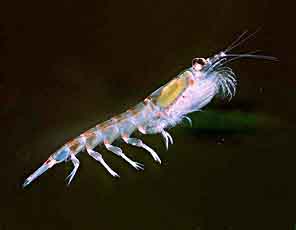Antarctic Krill (Euphausia superba) - Wiki Antarctic krill
From Wikipedia, the free encyclopedia
[Photo] Espa??ol: Krill ant??rtico. Antarctic krill Euphausia superba (Photo by Uwe Kils) larger images http://www.ecoscope.com/krill/index.htm
Antarctic krill (Euphausia superba[a]) is a species of krill found in the Antarctic waters of the Southern Ocean. Antarctic krill are shrimp-like invertebrates that live in large schools, called swarms, sometimes reaching densities of 10,000???30,000 individual animals per cubic meter.[1] They feed directly on minute phytoplankton, thereby using the primary production energy that the phytoplankton originally derived from the sun in order to sustain their pelagic (open ocean) life cycle.[2] They grow to a length of 6 cm, weigh up to 2 g, and can live for up to six years. They are a key species in the Antarctic ecosystem and are, in terms of biomass, probably the most successful animal species on the planet (approximately 500 million tonnes).[3]
Systematics
All members of the krill order are shrimp-like animals of the crustacean superorder Eucarida. Their breastplate units, or thoracomers, are joined with the carapace. The short length of these thoracomers on each side of the carapace makes the gills of Antarctic krill visible to the human eye. The legs do not form a jaw structure, which differentiates this order from the crabs, lobsters and shrimp.
Life cycle
The main spawning season of Antarctic krill is from January to March, both above the continental shelf and also in the upper region of deep sea oceanic areas. In the typical way of all euphausiaceans, the male attaches a sperm package to the genital opening of the female. For this purpose, the first pleopods (legs attached to the abdomen) of the male are constructed as mating tools. Females lay 6,000???10,000 eggs at one time. They are fertilized as they pass out of the genital opening by sperm liberated from spermatophores which have been attached by the males.[4]
According to the classical hypothesis of Marr,[5] derived from the results of the expedition of the famous British research vessel RRS Discovery, egg development then proceeds as follows: gastrulation (development of egg into embryo) sets in during the descent of the 0.6 mm eggs on the shelf at the bottom, in oceanic areas in depths around 2,000???3,000 m. From the time the egg hatches, the 1st nauplius (i.e., larval stage) starts migrating towards the surface with the aid of its three pairs of legs; the so-called developmental ascent.
The next two larval stages, termed 2nd nauplius and metanauplius, still do not eat but are nourished by the remaining yolk. After three weeks, the little krill has finished the ascent. They can appear in enormous numbers counting 2 per liter in 60 m water depth. Growing larger, additional larval stages follow (2nd and 3rd calyptopis, 1st to 6th furcilia). They are characterized by increasing development of the additional legs, the compound eyes and the setae (bristles). At 15 mm, the juvenile krill resembles the habitus of the adults. Krill reach maturity after two to three years. Like all crustaceans, krill must molt in order to grow. Approximately every 13 to 20 days, krill shed their chitinous exoskeleton and leave it behind as exuvia.
...
http://en.wikipedia.org/wiki/Antarctic_krill
| The text in this page is based on the copyrighted Wikipedia article shown in above URL. It is used under the GNU Free Documentation License. You may redistribute it, verbatim or modified, providing that you comply with the terms of the GFDL. |
